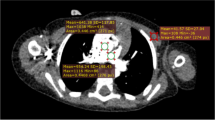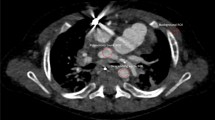Abstract
Background:
There are only a few reports on the diagnostic accuracy, and the technical and clinical feasibility, of multidetector CT (MDCT) in infants with congenital heart disease (CHD).
Objective:
To evaluate the image quality and radiation dose of DSCT in babies with CHD.
Materials and methods:
From November 2006 to November 2007, 110 consecutive infants with CHD referred for pre- or postoperative CT evaluation were included. All these infants had a spiral angiothoracic DSCT scan after injection of 300 mg/ml iopromide at 0.5–1 ml/s with a power injector using a low-dose protocol (80 kVp and 10 mAs/kg). Of these infants, 34 also underwent an ECG-gated coronary CT scan for evaluation of the course of the coronary arteries.
Results:
No serious adverse events were recorded. The mean dose-length product was 8±6 mGy.cm (effective dose 0.5±0.2 mSv) and 21±9 mGy.cm (effective dose 1.3±0.6 mSv) during the non-ECG-gated spiral acquisition and ECG-gated acquisition, respectively. Diagnostic quality images were achieved with the spiral acquisition in 89% of cases. Compared to the spiral mode, ECG-gated acquisition significantly improved the visualization of the coronary arteries, with a diagnostic rate of 91% and 84% for the left and right coronary arteries, respectively.
Conclusion:
DSCT together with iopromide at 300 mg/ml is a valuable tool for the routine clinical evaluation of infants with CHD. ECG-gated acquisition provides reliable visualization of the course of the coronary arteries.





Similar content being viewed by others
References
Hamoir X, Salovic D, Bouziane T et al (2007) Dual source CT: cardio-pulmonary applications. JBR-BTR 90:77–79
Johnson TR, Nikolaou K, Wintersperger BJ et al (2006) Dual-source CT cardiac imaging: initial experience. Eur Radiol 16:1409–1415
Gilkeson RC, Ciancibello L, Zahka K (2003) Pictorial essay. Multidetector CT evaluation of congenital heart disease in pediatric and adult patients. AJR 180:973–980
Goo HW, Park IS, Ko JK et al (2005) Computed tomography for the diagnosis of congenital heart disease in pediatric and adult patients. Int J Cardiovasc Imaging 21:347–365
Goo HW, Park IS, Ko JK et al (2005) Visibility of the origin and proximal course of coronary arteries on non-ECG-gated heart CT in patients with congenital heart disease. Pediatr Radiol 35:792–798
Jelnin V, Co J, Muneer B et al (2006) Three dimensional CT angiography for patients with congenital heart disease: scanning protocol for pediatric patients. Catheter Cardiovasc Interv 67:120–126
Khatri S, Varma SK, Khatri P et al (2008) 64-slice multidetector-row computed tomographic angiography for evaluating congenital heart disease. Pediatr Cardiol 29:755–762
Ou P, Celermajer DS, Calcagni G et al (2007) Three-dimensional CT scanning: a new diagnostic modality in congenital heart disease. Heart 93:908–913
Shrimpton PC (2004) 2004 CT quality criteria. Appendix C - assessment of patient dose in MSCT. National Radiation Protection Board, UK. http://www.msct.eu/PDF_FILES/EC%20CA%20Report%20D5%20-%20Dosimetry.pdf
Thomas KE, Wang B (2008) Age-specific effective doses for pediatric MSCT examinations at a large children’s hospital using DLP conversion coefficients: a simple estimation method. Pediatr Radiol 38:645–656
Lee T, Tsai IC, Fu YC et al (2006) Using multidetector-row CT in neonates with complex congenital heart disease to replace diagnostic cardiac catheterization for anatomical investigation: initial experiences in technical and clinical feasibility. Pediatr Radiol 36:1273–1282
Huda W, Vance A (2007) Patient radiation doses from adult and pediatric CT. AJR 188:540–546
Paul JF, Abada HT (2007) Strategies for reduction of radiation dose in cardiac multislice CT. Eur Radiol 17:2028–2037
Paul JF, Abada HT, Sigal-Cinqualbre A (2004) Should low-kilovoltage chest CT protocols be the rule for pediatric patients? AJR 183:1172; author reply 1172
Goo HW, Suh DS (2006) Tube current reduction in pediatric non-ECG-gated heart CT by combined tube current modulation. Pediatr Radiol 36:344–351
Sigal-Cinqualbre AB, Hennequin R, Abada HT et al (2004) Low-kilovoltage multi-detector row chest CT in adults: feasibility and effect on image quality and iodine dose. Radiology 231:169–174
Thomsen HS, Morcos SK (2008) Risk of contrast-medium-induced nephropathy in high-risk patients undergoing MDCT - A pooled analysis of two randomized trials. Eur Radiol Nov 11. Epub ahead of print
Mikkonen R, Kontkanen T, Kivisaari L (1995) Late and acute adverse reactions to iohexol in a pediatric population. Pediatr Radiol 25:350–352
Katayama H, Yamaguchi K, Kozuka T et al (1990) Adverse reactions to ionic and nonionic contrast media. A report from the Japanese Committee on the Safety of Contrast Media. Radiology 175:621–628
Lambert V, Sigal-Cinqualbre A, Belli E et al (2005) Preoperative and postoperative evaluation of airways compression in pediatric patients with 3-dimensional multislice computed tomographic scanning: effect on surgical management. J Thorac Cardiovasc Surg 129:1111–1118
Leschka S, Oechslin E, Husmann L et al (2007) Pre- and postoperative evaluation of congenital heart disease in children and adults with 64-section CT. Radiographics 27:829–846
Hayabuchi Y, Mori K, Kitagawa T et al (2007) Accurate quantification of pulmonary artery diameter in patients with cyanotic congenital heart disease using multidetector-row computed tomography. Am Heart J 154:783–788
Arnold R, Ley S, Ley-Zaporozhan J et al (2007) Visualization of coronary arteries in patients after childhood Kawasaki syndrome: value of multidetector CT and MR imaging in comparison to conventional coronary catheterization. Pediatr Radiol 37:998–1006
Tsai IC, Lee T, Chen MC et al (2007) Visualization of neonatal coronary arteries on multidetector row CT: ECG-gated versus non-ECG-gated technique. Pediatr Radiol 37:818–825
Matt D, Scheffel H, Leschka S et al (2007) Dual-source CT coronary angiography: image quality, mean heart rate, and heart rate variability. AJR 189:567–573
Author information
Authors and Affiliations
Corresponding author
Rights and permissions
About this article
Cite this article
Saad, M.B., Rohnean, A., Sigal-Cinqualbre, A. et al. Evaluation of image quality and radiation dose of thoracic and coronary dual-source CT in 110 infants with congenital heart disease. Pediatr Radiol 39, 668–676 (2009). https://doi.org/10.1007/s00247-009-1209-6
Received:
Revised:
Accepted:
Published:
Issue Date:
DOI: https://doi.org/10.1007/s00247-009-1209-6




